By Indra
In many ways, the Black Rock City Census every year tells the stories of the Burning Man event’s 70,000+ participants: Who are they — how old, from where? What do they do? Why did they choose to spend their vacations in a dusty, far-away corner of the world?
These are some of the questions I ask when I make new friends on the playa. Lucky for us both, the 2018 Census report is live, and it has all this, plus lots of other fun facts about Burning Man 2018. It also all the serious questions that help Burning Man Project make Burning Man more inclusive, safe, and accessible.
The BRC Census collects this information in two phases. First, we randomly select vehicles entering Black Rock City and ask each participant to fill out a short questionnaire. Second, we ask all Burners to fill out the full Census questionnaire beginning Tuesday after the Man burns (bookmark the link now).
Because not all Burners choose to fill out the full questionnaire (even though it’s a fun 20 minutes!), we use the demographic data from the random sample to adjust the results (in nerdspeak, we weight the data) so that they are representative of everyone at Burning Man.
Just as understanding the 10 Principles can deepen our playa experience, by reading through the Census Report we can immerse ourselves in the questions of who we are and what we want as a community. Below are a few of the things that I found interesting in this year’s Report.
Lots of Returning Burners, Here for Community and Art
Every year, it’s a hot topic of conversation that such a high percentage of participants are virgins. But in 2018, that percentage dropped significantly over previous years, and we saw an influx of participants who have come to Burning Man many times.
In 2018, 31.7% of participants were virgins, compared to 36.2% in 2017. Additionally, the percentage of Burners who’ve been eight to 11 times increased significantly (from 7.6% to 9.3%), as did the percentage of Burners who’ve attended 12–15 burns (from 3.5% to 4.8%) and the percentage who’ve attended more than 15 burns (from 3.6% to 5.0%).
Years Since First Burn
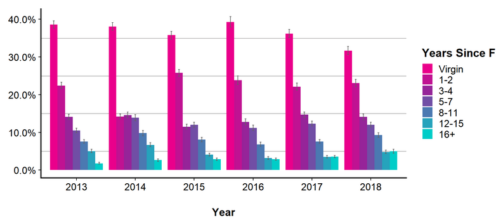
When I saw this, I wondered why so many longtime veterans attended, and my mind went to the passing of Larry Harvey, which reverberated across so much of the Burning Man community.
The responses participants gave for attending in 2018 were somewhat different from years past. Some of the notable increases over 2017 include the responses “to be with friends or like-minded people, or to feel a sense of belonging” and “to see/experience the art” — from 57.7% to 62.1% and from 54.1% to 61.4%, respectively.
Reasons for Going to Black Rock City This Year*
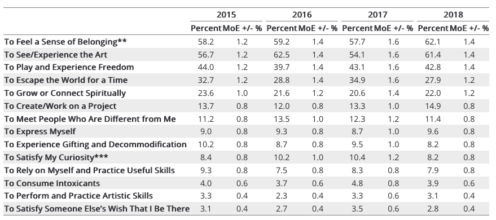
** The exact wording of the answer option in the online survey was, “To be with friends or like-minded people / feel a sense of belonging.”
*** The exact wording of the answer option in the online survey was, “To satisfy my curiosity / check it off my ‘bucket list.'”
Is Acculturation Working?
Critical to our culture, and the subject of many conversations among community members, are the 10 Principles. If my mentors and campmates hadn’t schooled me on these Principles, I personally don’t think I would have grokked what I was doing out there.
There is widespread agreement among community members that the 10 Principles are an essential reason why the experience is special. Last year showed a significant increase in the already large number of participants who view the principles as very important to creating an authentic Burning Man experience —from 73.3% in 2017 to 77.9% in 2018.
How Essential are the 10 Principles to Creating an Authentic Burning Man Experience?
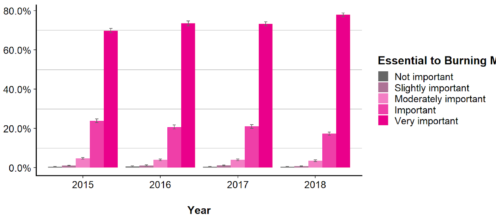
Burners are Arriving Sooner…
As I’m getting excited about planning for the event, a crucial question is how long I will spend on the playa — how early can I get in (depending on whether I have a Work Access Pass), and how long can I stay? So I’m always interested in how long people spend at the event.
In 2018, the number of people arriving Thursday before the event rose significantly over 2017 (14.6% to 18.3%), and there was a concurrent dip in the percentage of Sunday arrivals (39.9% to 35.6%).
Arrival Date to Black Rock City
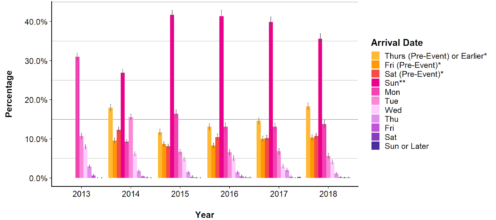
* Pre-event arrival data from the 2013 online survey have been removed because the survey question in 2013 was less precise than it was in later years, so the 2013 pre-event data is not directly comparable.
** In 2013 and 2014 Burning Man’s official opening date fell on a Monday, so for these years Sunday arrivals should be considered pre-event. From 2015-18 Burning Man opened on a Sunday, so for these years Sunday arrivals should not be considered pre-event arrivals.
…And Staying a Little Later, Longer
On the departure end, we see some interesting fluctuations over the years. In 2018, the percentage of Burners staying until Tuesday or later creeped up a bit after dipping significantly in 2015. Maybe folks were trying to escape the record heat in 2017.
Whatever the reason, 2018 saw the largest percentage of Burners staying 11-12 days (up 1.4 percentage points over 2017) and 12 or more days (up 2.3 percentage points over 2017) since the Census has been collecting generalizable data!
Departure Date from Black Rock City
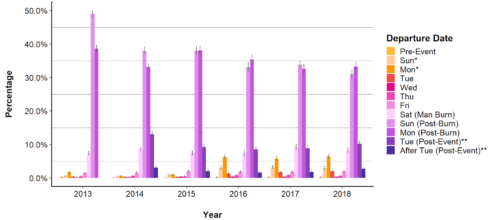
* In 2013 and 2014 Burning Man’s official opening date fell on a Monday, so for these years Sunday departures should be considered pre-event. From 2015-18 Burning Man opened on a Sunday, so for these years Sunday arrivals should not be considered pre-event departures.
** Post-event departure data from the 2013 online survey have been removed because the survey question in 2013 was less precise than it was in later years, so the 2013 pre-event data is not directly comparable.
Length of Stay

This post only scratches the surface of the sociodemographic and cultural insights available in the 2018 Black Rock City Census report, so I highly recommend checking it out. And if all this has piqued your interest in volunteering for Census, click here — we’d love to have you! Hope to meet you all out there in T-minus… not enough days.
Top photo by Joseph “JOBI” Buchman

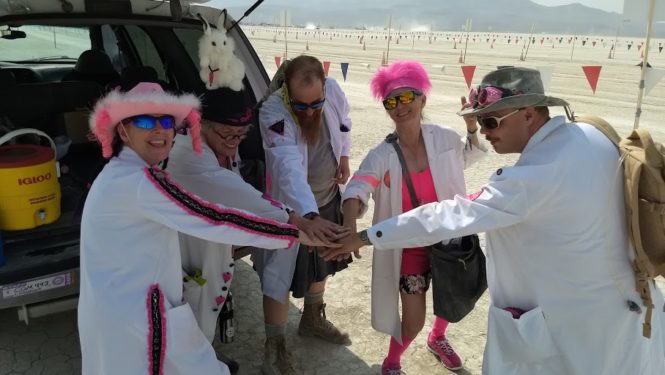
Thank you data nerds!
Report comment
Wasn’t it 2014 that it rained during exodus, meaning many people had to stay later that particular year?
Report comment
I grok your use of grokked! Data Nerds 4-EVER.
Report comment
Is Acculturation Working?
Report comment
Glad to see this as I was recently surprised via an academic group I interact with posting the following journal article.
Welcome to Wonderland? A Population Study of Intimate Experiences and Safe Sex at a Transformational Mass Gathering (Burning Man)
Cite this article as:
Beaulieu-Prévost, D., Cormier, M., Heller, S.M. et al. Arch Sex Behav (2019). https://doi.org/10.1007/s10508-019-01509-9
I had no idea when I filled out the survey one of those years, that I would see an academic article come out of it. I thought I was completing a survey that was to help with the festival, and no where did I see a release that I consented to be part of a study for an academic publication. I think that you should make that clearer and reading this article and the survey portal, no where do I see that it will be used for anything other than “making the festival better”
Report comment
Please, please, please go online after the burn and fill out the Census. This year has made us all realize just how important ‘data’ can be. You can’t negotiate without the facts. If you love Burning Man this is one way you can contribute. Gift your data. It takes a few minutes but it’s fun.
Report comment
My dusty hat is off to the census team. Great work.
For the serious data nerds out there, hit the “live” link in the text to get to the full report and lots of gory details. Note that 1.4% of those attending in 2018 were age 70 or older!
Report comment
Dear Barbara Neilson,
as mentioned in the first paragraph of the consent form of the online BRC Census (the form that has to be read and accepted to access the online survey), “The results of this survey are distributed in reports on the Burning Man website, at the Census Lab in Black Rock City, and in academic publications. The information is also used by the Burning Man organization to improve the event and to better represent the interests of the people of Black Rock City in negotiations with authorities in the state of Nevada and the US federal government.” This paragraph was included in the consent form in previous years and will also be included in the 2019 edition.
In recent years, we also started to divide the online survey into three parts. i.e., Pt1(Sociodemographics and general questions), Pt2(Event logistic questions, mainly used to help various departements of the Burning Man Project), and Pt3(Questions from research collaborators within the BRC Census lab). In the 2019 edition, this information is provided (in more details) at the beginning of the survey and before each of the three parts. This was done to allow participants to better understand the purpose of the questions being asked, and to allow them to forgo the last part if they prefer not to answer the questions provided by the research collaborators.
I would also like to restate that all information collected in the online survey is always kept strictly confidential.
However, we understand that you might have missed or forgotten that information and that we could restate it regularly in our public communications to help burners better understand the work done at the Census lab. I will thus take that opportunity to briefly summarize how the results of the Census are used and where more information can be found on the topic.
The Census team indeed works on many projects, communicate their findings in many ways and has always been as transparent as possible about it. As we explain on the BRC Census web page (go to “burningman(dot)org/event/volunteering/teams/census/” and click Census citations), we produce a yearly report, publish posts in the Burning Man Journal, publish academic publications (at least since 2011) and present in academic conferences. We also help various Burning Man Project departments by providing them with relevant population estimates on various topics (e.g., economic impact in Nevada, BMIR ratings, level of carpooling,…).
Feel free to read our posts in the Burning Man Journal to have an idea of the topics on which members of the Census lab work. In addition, people who still have unanswered questions can send them to us at census(at)burningman(dot)org. And as the research collaborator in charge of the of ethics approval of the online survey by an Institutional Review Board since 2016, you can also contact me at hunter(at)butningman(dot)org or beaulieu-prevost.dominic(at)uqam(dot)ca.
We hope that these explanation can help you (and other readers) better understand the work done at the BRC Census lab.
Sincerely,
Dominic Beaulieu-Prévost, aka Hunter
Research collaborator and Main analyst at the BRC Census Lab
Professor at Université du Québec à Montréal, Canada
Report comment
Comments are closed.